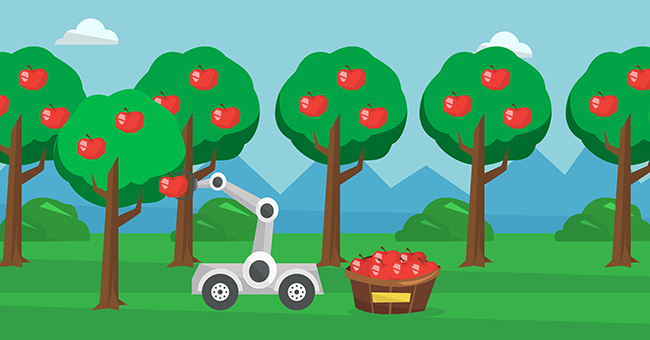Robotics technology has been a staple of certain manufacturing subsectors (automotive, aerospace, etc) since the 1950s, far longer than most people think. Food and beverage manufacturing isn’t a subsector most of the general public would associate with robotics.
However, robotics are widely used in the largest food manufacturing facilities worldwide, in a variety of use cases. The benefits of robots aren’t limited to food manufactures with sky high capital budgets. Thanks to advances in the past decade, food and beverage manufacturers of all sizes can leverage the benefits of this technology.
Use Cases
Let’s start with walking through the most popular use cases for robotics in most food manufacturing facilities, of any size. While these are the most common, it’s not an exhaustive list. If you’re considering a use case that isn’t discussed here, consider whether the physical operation is both predictable and repeatable. Is the target object of the physical operation presented in the same way every time? Does the target weigh the same? Is the path that a robotic arm would take to accomplish the task identical for reach repetition? If so, it’s likely a good fit for robotics.
By far the most common use case in food manufacturing is end of line packaging, firstly palletizing followed by case packing. These are so popular because once most food products are fully enclosed, they’re identical to any other widget from an operational standpoint. This means that palletizing cells designed and utilized primarily in other CPG sectors are plug-and-play for food manufacturing. Case packing can be more complicated, depending on the packaging for a specific product. Products without rigid packaging can be tough for robotic arms to securely grasp with traditional tooling, and products in very small containers can present a speed problem that would require multiple robots in a single cell to overcome.
Front end pick and place operations like depalletizing, conveyor loading, etc. are also excellent applications for robotics, but are much less common generally in food and beverage outside certain product categories.
Use cases that are far less common, but still completely feasible depending on the specifics of different production processes, are food contact applications. The most feasible food contact applications for robotics are product agitation for specialty liquid or bulk solid products where container agitation isn’t available or sufficient, or pick and place on exposed product, usually container packing.
Food contact applications are more uncommon, for some reasons that are good and some that aren’t. While concerns around end of arm tooling affecting delicate products and robotics keeping up with required throughput are perfectly reasonable, concerns about cleaning robotic arms and end of arm tooling are mostly based on a lack of understanding.
Food Safety Considerations Around Robotics
If we consider the end-of-line packaging use cases presented initially, these operations typically happen outside of the sanitary production room, most of the time in spaces with just minimum GMP protocols. With fully enclosed food products, this means that the robotic cells themselves can be treated like any case erector or sealer and cleaned minimally, since risk is low.
For food contact applications, any robotic cell would need to comply with the cleaning regimen for the specific production process. Full washdown environments would seem to present an issue for the precise electronics required for robotic systems. However, washdown certified arm cowling and custom design soft shell shrouds for CPUs allow robotic cells to operate reliably without additional maintenance in high water environments.
Different Robotics Solutions
So, let’s discuss what a robotic solution for any given use case might actually look like. While there are a myriad of specialized robotic types and five fixed-type industrial robot categories recognized by the International Federation of Robotics, we’ll focus on the types most commonly used, especially in food and beverage. These are articulated, delta, and collaborative robots.
Traditional, fixed-place, industrial articulated robotic arms are exactly what most people think of when they picture a manufacturing robot. These arms usually have six axes to provide a high range of motion, can extend to a very long reach, and can also handle the highest amount of weight. While these units are robust and capable, they generally aren’t a good fit for small or midsize food manufacturers unless the use case deals with a very heavy pick and place operation or the ROI on the use case is very high. These units are expensive, take up a lot of space, and require a substantial amount of guarding to operate effectively, drastically reducing the flexibility of the overall production process.
Delta robots are lightweight, high-speed robots that are generally mounted over the top of production lines for pick and place operations that require high cycle frequency but not excessive range of motion. These robots specialize in container packing use cases, especially in multi-unit cells that handle high throughput lines. However, this capability comes at a high price, often with the highest initial investment of the three robot types we discuss today.
Lastly, let’s discuss collaborative robots, the category that is the best fit for a large majority of use cases in small and midsize food manufacturing facilities. Collaborative robots are similar to articulated units, in that they are multi-axis arms that are compatible with a variety of end of arm tooling. However, there are key differences. Collaborative robots are smaller, generally are not fixed (which is to say they are often mounted on wheels or rails), have a more limited reach and max weight capacity, and most importantly require zero safety guarding. This is because collaborative robots are force-limiting, they are built with sensors that detect nearby obstacles and objects in order to prevent collisions. This makes collaborative robots safe for human operators to work “in collaboration” with, and allows for easy one-to-one automation of some manual tasks. Collaborative robots also have lower utility requirements, often running on 120V outlets, and cost far less, with entry level models starting in the $30,000 range.
These unique aspects of collaborative robots make them a great fit for small and midsize food manufacturers to automate the low hanging fruit that is end of line packaging and palletization. In fact, this is such a great value that multiple robot integrators build off-the-shelf palletizing cells that incorporate feed conveyors and integrated controls all for under $100,000. This type of plug-and-play solution is an incredible value for almost any small food manufacturer still manually building pallets.
Additionally, collaborative robots are available in full washdown configurations for food contact applications. CIFT uses a FANUC CRX collaborative robot at our shared-use commercial kitchen in a full washdown environment for food contact tasks.
Conclusion
Robotics can offer a significant amount of value to food manufacturers of all sizes. Collaborative platforms provide the best bang for the buck and are a great place to start for most companies. Lastly, don’t be afraid to utilize robotics in food contact applications, if the use case is feasible otherwise.







